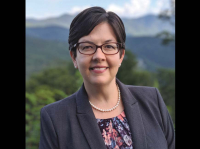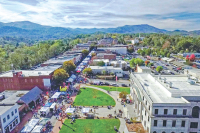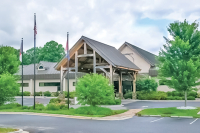Highlands lowering lake for major repairs
 Lake Sequoyah in Highlands is currently being drained in preparation for completing about $3 million in repairs to the dam.
Lake Sequoyah in Highlands is currently being drained in preparation for completing about $3 million in repairs to the dam.
Macon, Jackson negotiate payment for services
Macon County is asking Jackson County for money to pay for providing services to its residents in Highlands, but Jackson officials are exploring other alternatives, including establishing fire districts and levying a tax.
Macon County has requested about $160,000 from Jackson County to continue offering emergency services to residences in Highlands that are technically located in Jackson County. While Jackson County receives the property tax revenue from these homes, Macon County is burdened with the responsibility of providing emergency services.
Tapping into Appalachia
 Dale Heinlein never thought he’d set roots down in his hometown of Highlands.
Dale Heinlein never thought he’d set roots down in his hometown of Highlands.
“Living in Atlanta, in suburbia, with the summer heat and traffic, I had to get back to the mountains, back to nature, back to the earth, back to the rivers to cool off,” the 34-year-old said. “I’ve spent most of my life in Highlands and when I came back, I just started to notice so many things about my surroundings I either didn’t know about or had forgotten — there is so much to learn and discover everyday here.”
Tapping into Macon County
 Dale Heinlein never thought he’d set down roots in his hometown of Highlands.
Dale Heinlein never thought he’d set down roots in his hometown of Highlands.
“Living in Atlanta, in suburbia, with the summer heat and traffic, I had to get back to the mountains, back to nature, back to the earth, back to the rivers to cool off,” the 34-year-old said. “I’ve spent most of my life in Highlands and when I came back, I just started to notice so many things about my surroundings I either didn’t know about or had forgotten — there is so much to learn and discover everyday here.”
Highlands pursues new Verizon tower
Highlands residents will soon be seeing better cell phone coverage in town following the town board’s unanimous vote to move forward in negotiating a contract with Verizon Wireless.
Franklin brewery readies for spring opening
 As the snow melts in Southern Appalachia, the beer will begin to flow from the taps of the Lazy Hiker Brewing Company in the former Franklin Town Hall.
As the snow melts in Southern Appalachia, the beer will begin to flow from the taps of the Lazy Hiker Brewing Company in the former Franklin Town Hall.
Highlands to undertake $2.5 million project on Lake Sequoyah
 Lake Sequoyah will disappear for a few months in the coming year as Highlands plans to drain the reservoir to complete a pair of projects there. Combining $1.6 million in grant money from the Environmental Protection Agency with another $950,000 of town funds, Highlands plans to install a new intake valve in a deep part of the lake and complete some much-needed maintenance on the dam itself.
Lake Sequoyah will disappear for a few months in the coming year as Highlands plans to drain the reservoir to complete a pair of projects there. Combining $1.6 million in grant money from the Environmental Protection Agency with another $950,000 of town funds, Highlands plans to install a new intake valve in a deep part of the lake and complete some much-needed maintenance on the dam itself.
Highlands & Cashiers
Highlands and Cashiers are perched on the edge of the Blue Ridge Escarpment, where the mountains plunge sharply from a high plateau, creating the right ingredients not only for bountiful waterfalls but a temperate rainforest, one of the few in North America. This makes for lush vegetation, plus special designations such as “salamander and lichen capital of the world.”
Enclosed pool coming to Highlands
A $1.1 million donation from residents Art and Angela Williams of the Old Edwards Inn will net the town of Highlands a retractable roof for its new swimming pool, a new floor and bleachers for the civic center gym and a jumpstart toward a revitalized recreation program. And, possibly, a half-cent property tax increase to fund it.
The big screen comes to a small town
By Colby Dunn • Correspondent
For residents of Highlands, the list of things to do in town, depending on the season, can be pretty short and “go to the movies” has never been on it. But the town is filmless no more, thanks to a new program at the Highlands Playhouse that’s bringing in the blockbusters four nights a week.









